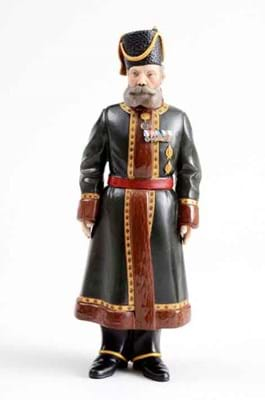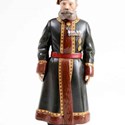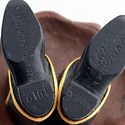The total number of Fabergé hardstone figure carvings produced by Fabergé is probably no more than 50, placing them on a level of rarity with the Imperial Easter eggs. Figures that depict actual historical persons rather than simply 'types' are deemed rarer still.
This 7in (18cm) figure depicts Nikolai Nikolaievich Pustynnikov, the personal Cossack bodyguard or Kamer-Kazak to the Empress Alexandra Feodorovna. He wears a long nephrite and jasper coat affixed with gold and enamelled orders and medals. The heels and soles of the boots are inscribed in Cyrillic capitals Fabergé 1912 and N.N.Pustynnikov, Kamer-Kazak since 1894.
It was one of two commissioned by Nicholas II himself - a companion figure of the Kamer-Kazak to the Dowager Empress Maria Feodorovna is in the collections of the State Pavlovsk Museum, near St Petersburg.
The personal bodyguards to the Empress and Dowager Empress accompanied them whenever they left their residences and were held in high esteem by the Imperial family, which explains Nicholas's desire to commemorate them in this fashion.
Life Models
Based on wax models taken from life (surviving photographs suggest they were a good likeness), their mammoth cost of 2300 rubles each was more than twice the price of any other Fabergé hardstone figure purchased by Nicholas II during the period 1908 to 1912. By way of comparison, a figure of a boyar (sold by Sotheby's New York in April 2005 at $1.8m - the previous record for a Fabergé figure) had cost the Tsar 950 rubles.
This figure of Pustynnikov was also kept at Pavlovsk until the 1920s when it left Russia with the American entrepreneur and art dealer Armand Hammer, who subsequently sold it to George H. Davis, a descendant of the present consignor, on December 11, 1934.
It was well known to collectors (both the original drawings and the invoice from the Fabergé workshops have been published), but its whereabouts was unknown until three months ago when it was found, contained in its original holly case, in an attic by the executor of a Rhinebeck, New York, estate.
Stair Galleries sought help from Fabergé author Gerard Hill in cataloguing the lot and gave it an estimate of $500,000-800,000. In fact, after a full 15 minutes of bidding on October 26 it sold at $5.2m (£3.38m) to the London jewellers Wartski who were bidding on the phone. It is not clear if they were purchasing it for stock or a private client.
They said: "Wartski were Armand Hammer's prime rivals in the 1920s and 1930s when buying the confiscated Imperial treasures from the Soviet government. We have, over the years, owned 20 of these rare hardstone figures, as well as a dozen of the legendary Imperial Easter eggs."
The buyer's premium was 17%.








